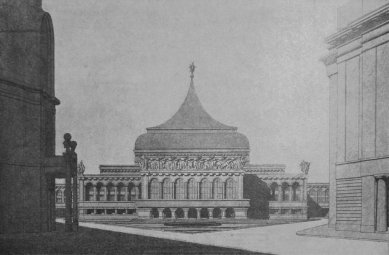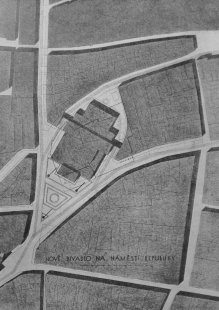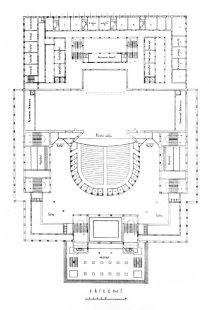
Idea competition for the placement of the New National Theatre in Prague
„N“ green in a red field

a) Republic Square. In Republic Square, the site of the new theater building primarily considers the location of the current Jiří z Poděbrad barracks. It has proven necessary for this site to be rounded off with some additional objects. These are primarily: the St. Joseph Monastery and four residential buildings on Truhlářská Street. On such a rounded-off construction site, Poříčí or Revolutionary Avenue provides certain bases that could become the starting point for the solution. However, if the building is oriented towards one of these streets, it will neither have sufficient distance nor will it provide particularly striking views. The author therefore proposes that today's Republic Square be used as a favorable viewpoint and that the main axis of the building be oriented in the direction of the opening between the Municipal House and the customs office. Both of these buildings create a sort of frame that opens up a direct view of the widely arranged facade of the theater, designed with this frontal view in mind. This location for the theater would fit the character of Prague, where the streets generally point towards and are enclosed by significant objects. In this place, a whole arrangement of visually enclosed streets would be created: Příkopy ending with the customs office, the square between the customs office and the Municipal House ending with the new theater building, and further Revolutionary Avenue with the prospect of the new parliament building in Letná. Republic Square is today relatively the liveliest center of the city, which can be a significant reason for placing the new theater building in this square. The project suggests how the space of Republic Square could be artistically resolved. The theater building occupies an entire side of the square, and its facade is designed to form not only a wall of the square but also a perfect prospect for views from the Powder Gate. The two adjacent corners, along Revolutionary Avenue and on Poříčí, should be architecturally connected to the facade: This corner could be exclusively used for the placement of a restaurant, etc. The square will take on a triangular shape, which is architecturally very amenable to resolution. The triangular area, located in the center of the square among the various communication directions, could be architecturally most effectively resolved. Its center would feature a large basin with a fountain. The airspace of the square would be defined by three monumental masts for lighting. Electric tram tracks could form a loop around the theater building.
b) Vrchlický Gardens. The placement of the theater building in Vrchlický Gardens cannot be resolved solely from the standpoint of the theater. Wilson Station is a very important factor in this situation, and its significant relations to the city require that the situation be deeply resolved according to its needs. The Vrchlický Gardens represent, from the perspective of easy communication, a highly difficult obstacle that cannot be penetrated to the center of the city and must be circumvented by a large detour. The gardens represent an almost 500-meter detour towards the Powder Gate. Finally, a third important factor comes into play: the future new powerful communication line: Freedom Bridge ― Sokolská Street ― Mariánská Street ― Hlávkův Bridge. Therefore, the author proposes a profound adjustment of this entire situation: he suggests that an urban avenue be created in the space of today's Vrchlický Gardens, starting from the National Museum and leading in a width of 60 meters towards Wilson Station. Here it branches off into a branch towards the underpass beneath Masaryk Station and a branch along the facade of Wilson Station. The garden itself will thus be reduced in area; however, the needs of this situation demand it. The remaining part of the gardens will create a garden space in front of the southern facade of the theater, bordered by an architectural colonnade, which would both terminate the garden and could serve commercial purposes. Wilson Station could receive substantial expansion through a proposed low extension that would utilize the height difference in the form of a monumental pedestal. The author finally proposes to establish a shorter passage from here towards the Powder Gate by widening Růžová Street, from where one could cross through the square in front of St. Henry's Church to Havlíček Square into Senovážná Street.
b) Vrchlický Gardens. The placement of the theater building in Vrchlický Gardens cannot be resolved solely from the standpoint of the theater. Wilson Station is a very important factor in this situation, and its significant relations to the city require that the situation be deeply resolved according to its needs. The Vrchlický Gardens represent, from the perspective of easy communication, a highly difficult obstacle that cannot be penetrated to the center of the city and must be circumvented by a large detour. The gardens represent an almost 500-meter detour towards the Powder Gate. Finally, a third important factor comes into play: the future new powerful communication line: Freedom Bridge ― Sokolská Street ― Mariánská Street ― Hlávkův Bridge. Therefore, the author proposes a profound adjustment of this entire situation: he suggests that an urban avenue be created in the space of today's Vrchlický Gardens, starting from the National Museum and leading in a width of 60 meters towards Wilson Station. Here it branches off into a branch towards the underpass beneath Masaryk Station and a branch along the facade of Wilson Station. The garden itself will thus be reduced in area; however, the needs of this situation demand it. The remaining part of the gardens will create a garden space in front of the southern facade of the theater, bordered by an architectural colonnade, which would both terminate the garden and could serve commercial purposes. Wilson Station could receive substantial expansion through a proposed low extension that would utilize the height difference in the form of a monumental pedestal. The author finally proposes to establish a shorter passage from here towards the Powder Gate by widening Růžová Street, from where one could cross through the square in front of St. Henry's Church to Havlíček Square into Senovážná Street.
The English translation is powered by AI tool. Switch to Czech to view the original text source.
0 comments
add comment















